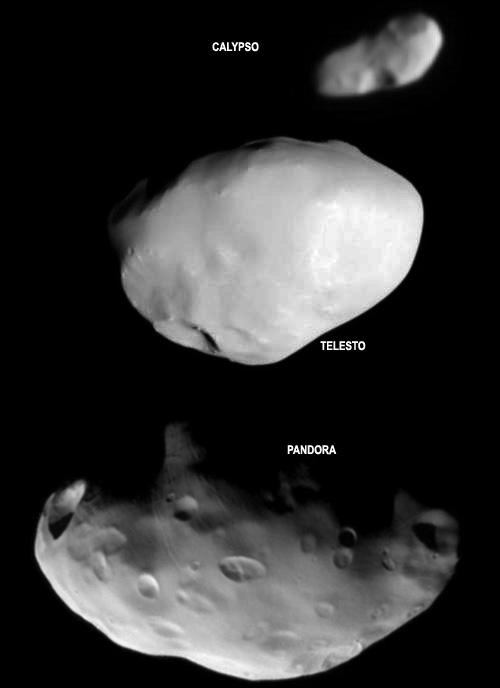
home •
about •
essential guide •
picture of the day •
thunderblogs •
news •
multimedia •
predictions •
products •
get involved •
contact
picture of the day archive subject index
Credit: Courtesy NASA/JPL-Caltech
May 15, 2007
Melted Moons
Spacecraft have discovered fine dust on several bodies. Recent images from the Saturn system show softening of features on several small moons that may also be due to dust. While an electrical explanation for this is at hand, there is also another intriguing electrical possibility.The Cassini mission to Saturn has recently acquired close-up images of several small moons. Telesto, Calypso and Pandora, shown above, display surface features that have been rounded and smoothed. In contrast, Hyperion and Enceladus, for example, have surface features that appear fresh and are sharply delineated. Mission scientists speculate that the three moons shown above may be covered with a loose material, perhaps a dust of fine ice crystals.
This is a reasonable speculation in view of the discovery that nearby Enceladus is venting water vapor and powdery ice particles from its south polar region. Enceladus may be supplying particles to the E ring, in which it orbits, and escaping particles may have settled on Telesto and Calypso. Pandora, just outside the F ring, may have picked up its coating in a similar way.
The Electric Universe takes into account that all these bodies—moons, rings and ice particles—move inside Saturn’s extensive plasma sheath. They are all therefore charged and subject to the electrical behavior of plasma. The fine icy dust that makes up the rings may have been etched—by an electrical discharge machining (EDM) process—from the sharp-featured moons. The same mechanism, with reversed polarity, will deposit the particles on a surface in thin layers. It is a process used in electrostatic spray painting of automobiles.
"Fineness" is an important indicator of electrical activity. Under low-energy conditions—discharges in the “dark” mode, which don’t have enough energy to emit visible light, or discharges in the “glow” mode, which only emit light feebly—electrical forces will tear only small particles from a surface in a process called “sputtering.” The same mechanism, with reversed polarity, will deposit the particles on a surface in thin layers.
Whether the surface is composed of ice or rock makes little difference. The icy dust being removed from Enceladus’s “hot” south polar region is matched with the sodium and sulfur particles being removed from Jupiter’s “hot” satellite, Io. And the fine dust that may cover Telesto, Calypso and Pandora is matched with the fine dust on Mars’ moons, Phobos and Deimos, and that thrown up on Comet Tempel 1 by Deep Impact.
In the Electric Universe, a galactic circuit powers this low-energy electrical activity in the Solar System. And there is evidence that the circuit has experienced surges that drive the activity into higher-energy arc (or thunderbolt) modes. “Sputtering” then would involve not fine dust measured in microns but boulders measured in miles, even asteroid-sized bodies. “Normal” conditions that we see today would be responsible for the existence of dust on and around Pandora and Enceladus; “catastrophic” conditions would be responsible for the existence of Pandora and Enceladus.
But in the electric Universe, there is another possibility. The "Electrical Parturition” model of satellite formation hypothesizes that solid bodies may be electrically ejected from gas giants. This would occur episodically: moons would be produced one or a few at a time.
After each episode of parturition, the new and existing moons would experience electrical discharges among themselves as they adjusted their orbits into a “least interaction” arrangement. Especially smaller bodies could be engulfed by a discharge channel, which, at a planetary scale, would persist for days. The small body would be subjected to a “plasma oven” effect that would produce a uniform melted layer over the surface. The process would be similar to that hypothesized for the generation of the glassy-surfaced chondrules in chondritic meteorites.
Telesto, Calypso and Pandora may not have had their craters and rilles softened by a layer of dust. Their craters and rilles may have been literally softened by melting. Radar measurements should be able to distinguish between the two.
NEW - Please Visit Our Forum
![]()
home •
thunderblogs •
forum •
picture of the day •
resources •
team •
updates •
contact us
EXECUTIVE EDITORS:
David Talbott, Wallace Thornhill
MANAGING EDITORS:
Steve Smith, Mel Acheson
CONTRIBUTING EDITORS: Michael Armstrong, Dwardu Cardona,
Ev Cochrane,
C.J. Ransom, Don Scott, Rens van der Sluijs, Ian Tresman
WEBMASTER: Brian Talbott
Copyright 2007: thunderbolts.info
